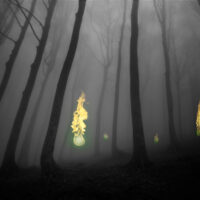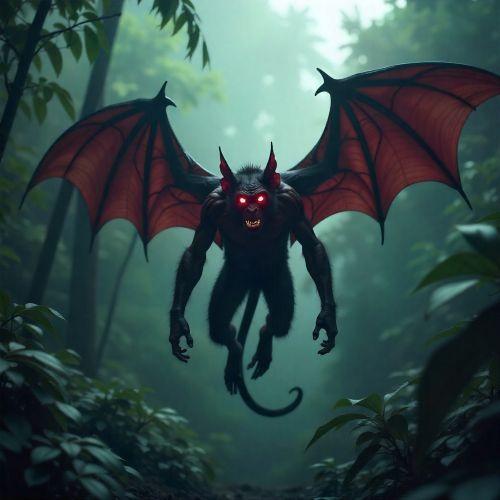Santelmo : The Fireball Spirit
Listen
At a glance
| Description | |
|---|---|
| Origin | Philippine Mythology |
| Classification | Gods |
| Family Members | N/A |
| Region | Philippines |
| Associated With | Fire, Shapeshifting |
Santelmo
Introduction
Santelmo, a legendary figure in Philippine mythology, is often portrayed as a glowing ball of fire roaming the countryside, particularly near water bodies and during stormy weather. The name “Santelmo” is derived from the Tagalog “Apoy ni San Elmo” or “St. Elmo’s Fire,” a term borrowed from the atmospheric phenomenon observed by sailors. Yet, while the scientific St. Elmo’s Fire is a plasma glow during thunderstorms, the Filipino Santelmo is far more spectral and steeped in folklore. This mythological entity carries strong connections to death, unfulfilled desires, and unresolved spiritual matters, often regarded as the manifestation of a soul that has not found peace.
Physical Traits
In Filipino stories, Santelmo takes the form of a fireball floating eerily through dark forests, rice fields, or over rivers. The light it emits can range from deep orange and red to ghostly blue or violet, shifting as it moves. The ball of flame behaves unpredictably—it hovers in silence, darts away suddenly, or dances playfully in the distance. In more modern interpretations, especially in urban legends and pop culture, Santelmo may appear more anthropomorphic, such as a burning human head or a spirit enveloped entirely in fire. This fire, unlike ordinary flames, seems intelligent and self-willed, guiding or misleading those who witness it.
Family
Unlike many mythological beings with elaborate family trees or divine lineages, Santelmo is usually thought to be a lone spirit. It is often interpreted as the restless soul of someone who met a tragic or violent end, especially near water or under mysterious circumstances. In some versions, Santelmo is said to be the essence of an unbaptized child or a person whose soul remains tethered to the physical world by strong emotional ties or unfinished business. Folk stories also suggest that if a corpse is not properly mourned or buried, the soul may manifest as a Santelmo. Though not part of a traditional mythological family, it may be categorized with elemental spirits like the diwata or enkanto, which also embody natural phenomena.
Other names
While “Santelmo” is the widely recognized term, the entity is known by various names across the Philippine archipelago. These regional names often emphasize either the light it emits or its mysterious nature. In Visayas and Cebu, it may be called bulalakaw, referring to its comet-like flight through the night sky. In the Ifugao region, it is fanfanilag, signifying an orb of light. The Ilokano people use the term allawig, which implies persuasion or trickery, reflecting the belief that Santelmo can lure travelers off their paths. These indigenous terms predate the Spanish-influenced “Santelmo,” showing that the belief in fiery spirit apparitions existed long before colonial times. Each local name reflects how communities perceive and interact with the phenomenon within their unique cultural context.
Powers and Abilities
The Santelmo is more than just a glowing orb—it is considered a spirit with distinct supernatural capabilities. Chief among them is its ability to lead people astray. Witnesses often describe feeling a strange compulsion to follow the light, only to find themselves lost or in danger. In rural stories, those who chase or get too close to a Santelmo may become disoriented, fall ill, or vanish entirely. It is also said to be a harbinger of misfortune or death, particularly if it appears close to one’s home.
Some narratives describe Santelmo as a shapeshifter, able to transform from a ball of fire into a beast, or even take on a human-like form engulfed in flame. There are tales of it setting fires in forests or grasslands, driven by rage or sorrow. The fire it emits is not natural—it can burn without fuel and resist wind or rain. In more mystical accounts, Santelmo is capable of communicating with the spiritually sensitive, offering cryptic messages or warnings. This duality—being both threatening and potentially insightful—adds to its enigmatic nature in Filipino folklore.
Modern Day Influence
Santelmo remains a relevant figure in contemporary Filipino culture, reimagined in literature, animation, and media. One of its most popular modern appearances is in Trese, a graphic novel turned Netflix series that dives deep into Philippine supernatural traditions. In Trese, Santelmo is given a new life as a fire elemental who aids the protagonist, symbolizing how mythological figures can evolve with time. The show portrays Santelmo not just as a terrifying force but as a spirit with intelligence and purpose, channeling the energy of past tragedies like the Great Binondo Fire.
Beyond entertainment, Santelmo’s presence persists in rural beliefs and practices. In some provinces, locals still light candles near sites of unexplained deaths to guide spirits toward peace, a ritual tied to the idea of preventing the formation of Santelmo. Books like The Amazing Beasts of Philippine Mythology reintroduce Santelmo to new generations, featuring it in vibrant illustrations and dual-language text, encouraging both preservation and cultural pride.
In academic circles, Santelmo is often discussed alongside global phenomena like will-o’-the-wisps or ignis fatuus, floating lights reported in other cultures. These comparisons highlight the universality of human attempts to explain the mysterious lights observed in nature. However, the emotional and spiritual depth that Santelmo holds in Filipino communities gives it a distinct place in mythological studies. Unlike the mere scientific curiosity of St. Elmo’s Fire, the Philippine Santelmo is a vessel of ancestral memory, folklore, and communal beliefs about life, death, and the afterlife.
Related Images
Source
Clark, J. (2016). Santelmo: Rekindling Philippine Mythology. The Aswang Project. https://www.aswangproject.com/santelmo/
Ramos, M. (1990). The Creatures of Midnight. Manila: CreateSpace Independent Publishing Platform.
Limos, M. A. (2021). The Enigmatic Philippine Origins of Trese’s Santelmo. Esquire Philippines. https://www.esquiremag.ph/long-reads/features/santelmo-origin-trese-a00293-20210614-lfrm
Spike, I. (2024). The Scorching Santelmo: Real or Myth?. HubPages. https://discover.hubpages.com/education/the-scorching-santelmo-myth-or-reality
Trese Wiki. (n.d.). Santelmo. https://trese.fandom.com/wiki/Santelmo
Frequently Asked Questions
What is lorem Ipsum?
I am text block. Click edit button to change this text. Lorem ipsum dolor sit amet, consectetur adipiscing elit. Ut elit tellus, luctus nec ullamcorper mattis, pulvinar dapibus leo.
What is lorem Ipsum?
I am text block. Click edit button to change this text. Lorem ipsum dolor sit amet, consectetur adipiscing elit. Ut elit tellus, luctus nec ullamcorper mattis, pulvinar dapibus leo.
What is lorem Ipsum?
I am text block. Click edit button to change this text. Lorem ipsum dolor sit amet, consectetur adipiscing elit. Ut elit tellus, luctus nec ullamcorper mattis, pulvinar dapibus leo.
What is lorem Ipsum?
I am text block. Click edit button to change this text. Lorem ipsum dolor sit amet, consectetur adipiscing elit. Ut elit tellus, luctus nec ullamcorper mattis, pulvinar dapibus leo.
What is lorem Ipsum?
I am text block. Click edit button to change this text. Lorem ipsum dolor sit amet, consectetur adipiscing elit. Ut elit tellus, luctus nec ullamcorper mattis, pulvinar dapibus leo.












